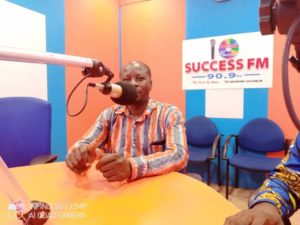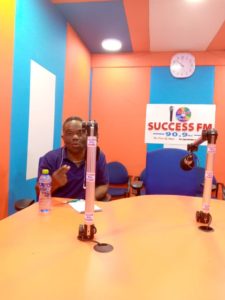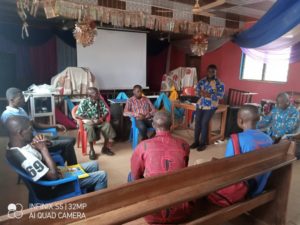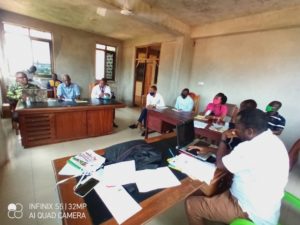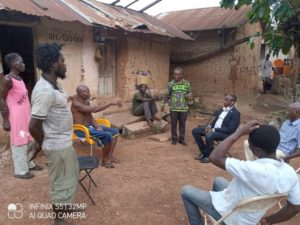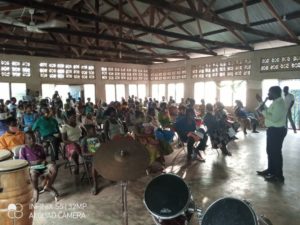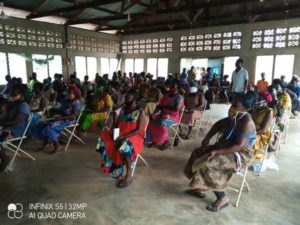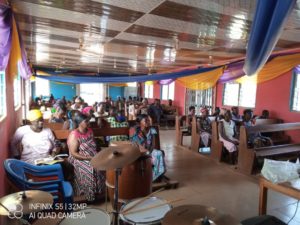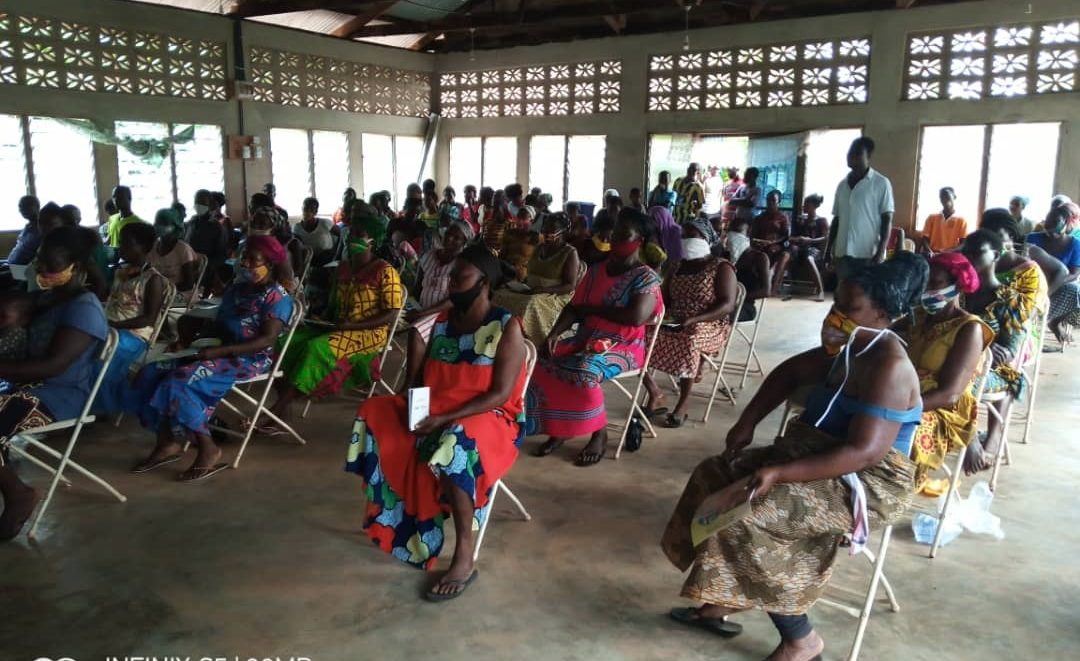
PILOTING THE LEAP BENEFICIARY COMMUNITY COMMUNICATION IN THE ASUNAFO NORTH MUNICIPAL ASSEMBLY
BY RESOURCE LINK FOUNDATION
Names of Facilitators: Christopher Dapaah, Prince Fofoe, Jack Asumadu and Dawud Suleiman
District: Asunafo North Municipal Assembly
Region: Ahafo Region
Date: 24th Sep – 10th Oct 2020
Language used: Twi & English
1.0 PREAMBLE
Over the years, Ghana has implemented several social protection strategies including the Livelihood Empowerment Against Poverty (LEAP) program with the primary objective of reducing poverty in society. LEAP is a cash transfer scheme that, provides direct cash to beneficiaries to support livelihoods and minimize extreme poverty through a bi-monthly payment cycle on an electronic platform.
2.0 INTRODUCTION
The LEAP program is managed by the Leap Management Secretariat (LMS) at the Ministry of Gender, Children and Social Protection. In an effort to enhance effective and efficient program delivery and empowering beneficiaries to demand accountability, the Secretariat engaged Civil Society Organizations from the Social Protection Platform and local institutions (DSW, ISD & NCCE) as third parties through the use of innovative communicative strategies to foster beneficiaries’ reflection, participation, response and ownership of the LEAP program.
The pilot exercise was carried out by Resource Link Foundation (Partner – civil society organisation) of the Social Protection Platform with support from UNICEF Ghana in the Asunafo North Municipal Assembly in the Ahafo Region.
A Team from Resource Link Foundation visited the Asunafo North Municipal Assembly in the Ahafo Region in September- October 2020 for this pilot. Two communities were selected from the district for this pilot. These communities are Kyenkyehene and Asuadei/Nyamebekyere.
The pilot was centered on the Livelihood Empowerment Against Poverty (LEAP) Beneficiaries’ Charter of Rights and Responsibilities. It is expected that this pilot exercise will enhance LEAP beneficiary and community communication and encourage ownership of the LEAP program in selected communities.
3.0 MAIN OBJECTIVES
The ultimate aim of this pilot was to sensitize beneficiaries of LEAP on their rights as beneficiaries as wells as responsibilities expected of them. Again, the pilot is to enhance communities’ understanding of the LEAP program and the role they play as stake holders.
4.0 METHODOLOGY
Community and beneficiary forums were organized for the two communities. Each community was handled or engaged separately. There were community forums for the two communities where members of these communities were met. Beneficiaries in the two communities were also organized separately and engaged.
The process was very successful as it gave all community members the opportunity to listen and share their thought about the LEAP program. Beneficiaries on the other hand also had the opportunity to share with us their thoughts about the LEAP program. All participants had a great opportunity to learn something new about the LEAP program.
5.0 MAIN ACTIVITIES
1. Community entries and inception meetings
The various stakeholders were given prior notice and served with letters about the pilot exercise. The assembly man and committee members in the area were met and briefed about the pilot program. The two communities happens to be in the same electoral area and so therefore has the same Assemblyman and unit committee. Together with the officer for LEAP in the district, members of the DLIC were served with letters inviting them to DLIC meeting. The DSWO, the CFPs were very instrumental in the community mobilisation and coordinating of activities. Jingle play alerted communities of entries to the community every day.
2. Media Engagement
On the 27th of September 2020, there was a panel discussion in the studios of Success FM in Goaso about the pilot exercise. The program was graced by the officer for LEAP in the district and a member from Resource Link Foundation. The program was part of preparations towards the start of the pilot exercise. The panel presented the picture of the pilot to cherished listeners. That is, the overview of the pilot exercise. The pilot outline was deliberated by the house and the aims and objectives of the exercise as well. Listeners were giving the opportunity to do phone-ins to seek for clarifications and contributions. The program lasted for an hour.
Local community information centres had been informed about the program and so they made announcements within the communities telling members to listen to us on Success FM.
3. DLIC meeting
A DLIC meeting was held on the 29th of September, 2020 at the Municipal Assembly mini hall. The meeting was chaired by the Assistant Director; Mr David Chutab.
Again, the Agric director, Educational director, Information Service department director, NCCE director, Social Welfare director, Opportunity Savings and Loans Manager, Planning Officer, Resource Link Foundation director and other officers from central administration well all present at the meeting. The pilot exercise was discussed thoroughly and a consensus was reached on how the Assembly and the DLIC committee will support the LEAP program. The meeting was also an opportunity to revamp the DLIC committee that had been dormant for some years now due to certain peculiar reasons. Members deliberated on how to sustain and maintain the committee to ensure active participation in the LEAP program. Further to this, the committee agreed to co-opt The Municipal Police commander to deploy personnel to ensure security of funds during LEAP funds payment periods considering the vulnerability of the beneficiaries as well as the Media for public education. Haven taken them through the Beneficiary charter of the rights and responsivities, Various roles of the Membership were detailed and asked that, each sector to dedicated committed representation including Health(nutrition/free birth certification issues) ,Department of Agriculture to check child labour issues, NCCE on the dissemination of policy issues to the public and ISD and the media for the announcement on any development intervention ,Ghana Education Service on checking the enrolment and retention of pupils in schools and submission of drop out reports, NHIS for the issuing of cards on timely basis, TA and Assembly members to monitor on the Use or purpose of the LEAP package to beneficiaries and MSWO to coordinate activities of the LEAP programme with the support of the Community focal Persons.
To conclude and sustain the functions of the DLIC, the Assistant Municipal Director who represented the coordinating director assured the committee gave the assurance to provide at the planning unit a space to accommodate budget to the activities of the committee.
Emphasising on the critical roles of the Resource Link Foundation (CSOs) in facilitating programmes in the District like LEAP, On behalf of the Municipality assured all of necessary support to achieve the purpose of the LEAP intervention to improving the livelihoods of the citizens. Some Copies of the IEC materials were distributed to the committee for timely and continues education on the Programme
4. Community forums
CFPs for the two communities led the team to the community traditional councils for introduction of the program. Prior notices had already been giving to the traditional councils about our visit and that facilitated an easy dialogue with authorities.
The overview of the pilot again was presented before the elders and they also gave their contributions and recommendations. We then sought permission from the councils to meet the community members. This protocol was duly utilized in the two communities. Finally, permission was granted to interact with the community at large. The communities honoured our invitations by coming out in their numbers to listen to what we had for them. For both communities, the program was held in the churches premises. The facilities were spacious enough to accommodate all members.
Again, for both communities, the Traditional council appointed members to come and witness the program. In Kyenkyehene, the chief was not in good health and so he delegated his linguist and an elder to come and witness the program while at Asuadei/Nyamebekyere, the chief together with his cabinet came to grace the occasion.
The developed jingle in both Twi and English for the pilot was played in the NCCE van on loud horn speakers while approaching the communities and also used as a welcome address before the community and beneficiary forums in both communities. It was played for about 3 times at the community and beneficiary forums before the main program started. The program started with a prayer from a community member. All IEC materials were shared to members who came to the forum. Community members were taking through all IEC materials strategically with flip chart and projector screens for an easy visibility and understanding.
Although some members were privileged to certain information about the LEAP program, it was also an opportunity for others to learn about the LEAP program. After our presentations, community members asked several questions about the program and facilitators gave precise responses to their questions. From their reactions after the forum, one could see that members were very happy and excited about the forum. The overall program was very interactive and interesting.
A documentary on LEAP Programme in other parts of the country were shown on the projected screen which gave further meanings and explanation of what , to whom , where and to how the proceeds from the LEAP has benefited the households and its multiplier effects on livelihoods improvements
The linguist gave a closing remarks and a short prayer was said by another community members.
More than 200 members from these two communities were covered during the community forums.
5. Beneficiary forums
Apart from the community forums that were organized for all members of the society, there was another forum that was organized for only beneficiaries of LEAP in the two communities. Beneficiaries were sensitized on the ‘Beneficiary Charter of Rights and Responsibilities’ concept. Their rights as beneficiaries were duly explained and discussed by facilitators into details. Some of the items discussed were things beneficiaries knew already while others looked very new to them. Again, their responsibilities as beneficiaries were also discussed. IEC materials explaining the Beneficiary Charter of Rights and Responsibilities were given to beneficiaries present at the two forums. Facilitators mentioned that each beneficiary had a reason why he/she was selected to be on the program and so the government expect him/her to do those responsibilities to help make the program effective
On the payment of funds to beneficiaries, it was indicated that, the funds disbursement were not realistic on individual and household basis and therefore they request for increment of funds on person by person basis , and further to cover all the PDWs , 60 years and above and vulnerable children as well as handling cost of expensive drugs.
6. Media engagement
Another media engagement was held with emphasis on the critical issues raised at the community interface meetings, further information on the plans of the Governments and other development policies to expand the LEAP programme, sustainability plans and ways of ensuring that, other citizens also benefit from the programme were discussed.
Conclusion
The pilot project was embarrassed by all stakeholders at every engagement. In light of COVID-19 pandemic, Evidence shows there is likely to be a significant increase in health conditions during and after COVID-19 which will require the need for critical health services and poverty alleviation packages. As such, consideration should be given to ways to integrate the delivery of psychosocial support to LEAP households and other vulnerable groups.
Pre-Testing the Social Accountability Tools for Social Protection in Ghana
1.0 Introduction
A team of two from a civil society organisation (Resource Link Foundation) of the Social Protection platform visited the Wenchi District of the Bono Region in February 2020 and conducted a focus group discussion. The Wenchi District is among the districts that were selected to enrol beneficiaries for the LEAP program. The district currently has a total of 1,923 beneficiaries enrolled on the LEAP program. Two communities were selected in the district to partake in this exercise; Koase and Awisa as well as district committee for the LEAP program (CLIC members). Koase has a total of 75 beneficiaries and Awisa also has a total of 99 beneficiaries. The focus group discussion involved 47 beneficiaries from the two communities and 11 district LEAP committee members.
Names of Facilitators: Christopher Dapaah and Dawud Suleiman
District; Wenchi Municipal
Region; Bono Region
Date; 17th – 21st February 2020
Number of participants; 58 participants
Language used; Twi & English
SUMMARY BACKGROUND
LEAP
Over the years, Ghana has implemented several social protection strategies including the Livelihood Empowerment Against Poverty (LEAP) programme, with the primary objective of reducing poverty by influencing consumption and improving access to basic social services.
LEAP is a cash transfer scheme that, provides direct cash to beneficiaries to support livelihoods and minimize extreme poverty through a bi-monthly payment cycle on an electronic platform.
THE NATIONAL SELECTION PROCESS
Beneficiaries are selected based on age, level of vulnerability and disability without productive capacity.
The selection process was manual until 2012 when a new information system was designed to support electronic targeting and payment to deal with challenges such as the selection of ineligible persons, data mismatch, and delays in processing payments for beneficiaries.
THE SECTOR MINISTRY
The LEAP programme started with 1, 654 households in 21 districts which increased to 54 in 2009. The programme expanded the number of household beneficiaries by 50,000 in 2016. Currently, the Leap programme serves 213,000 households across the country. Wenchi Municipality is one of the LEAP beneficiaries in the Bono Region. The district currently has a total of 1,923 beneficiaries enrolled on the LEAP program. The programme is managed by the LEAP secretariat and implemented by the Department of Social Welfare, both, under the Ministry of Gender and Social Protection, of Ghana.
LEAP INTERVENTIONS EXPECTATION
It is expected that the rising number of beneficiary households will translate into a reduction in poverty levels. The pathway to achieving this reduction, has been assessed by various academics and development institutions with missed results. The human face to the poverty reduction strategies, is usually missing from such engagements and the public discourse.
PARTNERSHIP /COLLABORATIVE WORK
This is the gap Civil society organizations led by world vision international in partnership with Resource Link Foundation in the Wenchi Municipality with the support of UNICEF Ghana office seek to bridge with this foregoing project, with the ultimate objective of understanding the impact of the programme on the beneficiaries and their preference for alternative and complementary strategies for poverty alleviation.
METHODOLY
Community score card through the Focus Group Discussions (FGDs) is an Accountability and integrity assessment tool used to collect the opinion s of local citizens’ beneficiaries or receiving the services about the quality of the LEAP services to determine an increase in family consumption, improved school enrolment and social inclusion.
The method was conducted in the well managed and professional manner that yielded a space for six(6) citizens groups of not more than 20 (Awisa- males and females, Koase- males amd females, Community LEAP Implementation committee, Focal Heads of Leap etc ) to raise critical questions over the effectiveness and determining complaints mechanism for policy reforms.
OBSERVATION/EXPERIENCE
2.0 Issues from the Discussions
2.1 Indicator 1 LEAP Awareness Level
As a group, we sought to find out how the selected communities have been sensitized and oriented on the LEAP programme. It was evident from our discussions that, LEAP officials from the national secretariat have been to the communities and have given them enough information and education on the program. The information officials gave beneficiary communities was fairly understood by beneficiaries in these communities. Again, the information given earned community members’ satisfaction on how beneficiaries were selected on to the program. Some CLIC members for these communities went ahead and gave additional orientation to beneficiaries prior to enrolment on the program while others failed to do so. This was revealed during our discussions with beneficiaries in these communities.
Summary Table
| No | Statement | Com. 1 | Com. 2 | Average Score |
| 1.1 | Community has been sensitized (amount, payment period, etc) on the LEAP implementation process. | 5 | 5 | 5 |
| 1.2 | District/Community LEAP Implementation Committee (D/CLIC) gave orientation to beneficiary households prior to enrolment. | 2.3 | 5 | 3.6 |
| 1.3 | LEAP beneficiaries know why they are on the programme. | 5 | 5 | 5 |
| 1.4 | LEAP beneficiaries know how they were selected on the programme. | 5 | 5 | 5 |
2.2 Indicator 2 Selection Process and Targeting
On the selection process and targeting under the LEAP program, we ascertained from our discussions with beneficiaries from selected communities that the processes were transparent enough and members of the community were satisfied. Beneficiaries from both communities as well as CLIC members unanimously expressed with much gratification that the processes involved in arriving at the right people to benefit from the program were adequately transparent and fair without any ambiguity.
Summary Table
| No | Statement | Com. 1 | Com. 2 | Average Score |
| 2.1 | The LEAP selection process is good | 5 | 5 | 5 |
| 2.2 | LEAP beneficiaries are satisfied with the selection process. | 5 | 5 | 5 |
| 2.3 | The selection process is transparent. | 5 | 5 | 5 |
2.3 Indicator 3 Effective Payment Process
We again sought the awareness of the communities on how effective the payment process for the program is. Beneficiaries were generally satisfied with the mode of payment in their respective communities. They added that the payment process has been very successful and effective. Beneficiaries from both communities as well as CLIC members were all of the view that beneficiaries have been receiving their expected amounts on time; every two months. Many among the beneficiaries we spoke to from these communities also asserted that they have been receiving their amounts in full with some few exceptions. Again, from our discussions in these two selected communities, Beneficiaries and district committee members for the program agreed that officials from LEAP have never asked them for a share of their cash transfers. However there were some few allegations about officers taking a share of beneficiaries’ benefits.
Summary Table
| No | Statement | Com. 1 | Com. 2 | Average Score |
| 3.1 | LEAP beneficiaries receive the expected amount on time. | 5 | 4 | 4.5 |
| 3.3 | LEAP beneficiaries are satisfied with payment process. | 5 | 5 | 5 |
| 3.4 | LEAP beneficiaries had often been asked to give a share of the benefit to people involved in the administrative, payment or selection process. | 1 | 2.3 | 1.6 |
| 3.5 | LEAP beneficiaries receive the expected amount in full with no deductions. | 5 | 3.6 | 4.3 |
2.4 Indicator 4 Case Management
Beneficiaries from these selected communities as well as CLIC members were of the view that members have been fairly sensitized on how to channel their complaints about the LEAP program to be solved. Participants were in agreement when we sought their views on whether they were aware of the complaint mechanisms under the LEAP program should they encounter any problem with the program. They stated that, they were told in their engagements with LEAP officials who visited them that the social welfare office at the municipal assembly will be responsible for handling all issues that may rise from the program. Again, it was also made clear to beneficiaries that they could reach the LEAP officer for the district through committee members who have been chosen by the LEAP officers to represent various communities in the municipal. The discussions also revealed that the LEAP officer has also informed beneficiaries to report all issues and problems about the programme to the LEAP office and he will ever be ready to help them.
We ascertained that some beneficiaries have been engaging the LEAP officials with their issues of concern. These beneficiaries mentioned that accessing the LEAP office isn’t something difficult and the LEAP officials always receive them politely and they again mentioned that they have been responding to the issues they present before them without delay. Other beneficiaries who have never accessed the LEAP office or engaged the LEAP officers also expressed their uncertainties about how their engagement with them will be when they finally engage them some day. They were not so specific whether it will be an easy access or a difficult one since they have never attended to them.
Summary Table
| No | Statement | Com. 1 | Com. 2 | Average Score |
| 4.1 | LEAP beneficiaries are aware of complaint mechanisms within LEAP. | 4.6 | 3.6 | 4.1 |
| 4.2 | Beneficiaries are able to send complaints to the LEAP office easily. | 4 | 3.6 | 3.8 |
| 4.3 | Complaints are resolved quickly by LEAP officials. | 5 | 3.6 | 4.3 |
| 4.4 | LEAP official are open to listen to beneficiaries at any time. | 5 | 4.3 | 4.6 |
2.5 Indicator 5 Benefits
The team continued discussions with participants on benefits of the LEAP program to ascertain how the program has been impacting the lives of beneficiaries and their households in these communities. Beneficiaries shared with us how helpful the program is to them and their entire households. A number of success stories were shared among beneficiaries as evidences of how the program is helping beneficiaries. Although members from these selected communities unanimously affirmed how helpful the program is, their views were however divided when we sought their views on whether they have been able to establish a businesses with the money they receive. While majority of participants argued strongly that the money wasn’t enough to start any business, few among them shared with us some businesses they have been able to set up with their shares of the cash transfer.
Summary Table
| No | Statement | Com. 1 | Com. 2 | Average Score |
| 5.1 | The money received has helped improved the living conditions of the household. | 5 | 5 | 5 |
| 5.2 | The money received has enabled the household to do things they could not have done. | 5 | 5 | 5 |
| 5.3 | The money received has enable beneficiaries established business. | 3.6 | 2.6 | 3.1 |
2.6 Indicator 6 Other Complementary Services
We also sought the views of beneficiaries from selected communities on other complementary services the LEAP program comes with. Our discussions revealed that LEAP officials have been treating beneficiaries with maximum respect. Beneficiaries in their assertions mentioned clearly that officers have never disrespected them even when they disobey them. Again, some beneficiaries asserted that community members uphold LEAP beneficiaries as their own without any stigmatization. However, some beneficiaries also believe that there are equally some members of society who look down upon. According to them the number of hours they spend in queuing for the amount they receive makes people laugh at them because they believe they could’ve used that number of hours to do something more productive that would earn them more than they receive on the LEAP program. Some bbeneficiaries and CLIC members asserted that being LEAP beneficiaries has enabled them to easily register NHIS but others were also opposing this view. Also while other beneficiaries have been privileged to free NHIS registration, many among the beneficiaries were unaware of such entitlement and therefore have been paying for the registration and renewals with the money they receive from the LEAP program. Moreover, all participants were emphatic that LEAP members don’t enjoy any special or preferential treatment when they visit the health centre. We continued the discussion by asking participants whether the LEAP program has helped beneficiary households to enrol their children in schools, and their answer was an overwhelming affirmation. We noticed that CLIC members have played their role in ensuring that all beneficiary households pay heed to this clause and parents have also exercise their control in ensuring that this aim is achieved. Finally we sought the view of participants on whether they have been involved in any decision making regarding reforms and policies about the LEAP program. Beneficiaries and CLIC members were having varying opinions. Majority among them were for the motion stating their reasons but few of them were also of the view that they’ve never been involved in such activity.
Summary Table
| No | Statement | Com. 1 | Com. 2 | Average Score |
| 6.1 | Staffs from LEAP offices treat beneficiaries with respect. | 5 | 4.3 | 4.6 |
| 6.2 | Community members do not look down upon LEAP beneficiaries as paupers. | 5 | 3.6 | 4.3 |
| 6.3 | LEAP beneficiaries are easily registered and provided with NHIS cards. | 2.6 | 5 | 3.8 |
| 6.4 | LEAP beneficiaries are registered and provided with NHIS cards for free. | 2.3 | 3.6 | 2.9 |
| 6.4 | LEAP beneficiaries access health services easily. | 1 | 1.3 | 1.1 |
| 6.5 | LEAP beneficiary households are able to send their children to school. | 5 | 5 | 5 |
| 6.6 | Beneficiaries are involved in decision making in relation to the LEAP implementation process. | 5 | 3.3 | 4.1 |
4.0 Key findings from the Discussions
- Some beneficiaries didn’t receive enough orientation about the program before enrolment
- Some CLIC members have not been engaging beneficiaries
- Some beneficiaries don’t know the exact amount they should receive
- Beneficiaries are not aware of entitlement to free NHIS registration
- Also, we discovered that beneficiaries did not have enough information/knowledge about the complaints mechanism under the programme. Many beneficiaries only send their concerns through the CLIC member (focal person).
- Some beneficiaries were not happy with payment schedule
5.0 Advocacy issues from the Discussions
- Payment schedule for communities
- Sensitization of communities on amounts they should receive
- Increase in the amount beneficiaries receive
- Creating of awareness among beneficiaries on free NHIS
6.0 Observations/Comments on the Tools (If Any)
6.1 The strengths of the tools
- The indicators capture almost all aspects of the LEAP program
- Beneficiaries could easily understood the smileys
- Beneficiaries were able to understand the indicators easily
- The smileys encourages beneficiaries’ participation in the discussions
6.2 The weakness of the tools
- Questions about NHIS were not so clear to some participants
- No space was provided to capture beneficiaries’ questions in the tool
6.3 What to do to improve the tools;
- The questions about NHIS should be framed in a such a way that beneficiaries will easily understand
- A space should be provided in the tool to capture any other comments from beneficiaries
6.4 The strengths of the process;
- Using the smileys make it easy for participants to respond to the questions
- The use of smileys get beneficiaries prepared before the start of the discussion
- Grouping beneficiaries among same gender makes them very comfortable
- Beneficiaries were able to express themselves very well
6.4 The weakness of the process;
- The FGD couldn’t capture half of the total number of beneficiaries in the community which makes difficult to make a general representation of their responses as that of the entire community
- There was among the beneficiaries a blind man who could not see the smileys
- Many beneficiaries wanted to be part of the discussion but were not allowed due to the number of participants preferred
6.5 What to do to improve the process;
- The FGD should cover at least half of the number of beneficiaries so that we can make informed judgements as a true representation for a particular community.
- Facilitators should be able to use their own discretion to select the number of beneficiaries to participate in the discussion
6.6 Other recommendations
- Beneficiaries who may not see well must be given a second attention to ensure their full participation.
- The focus group discussion should be organized for at least half of the total number of beneficiaries in selected communities so that their responses can be used for generalization purposes. This is because, beneficiaries seemed to have varying opinions on questions that were asked.
- Periodic sensitization of beneficiaries on the program to keep beneficiaries informed about the contents of the program
7.0 Report Summary
The team of civil society organisation of the Social Protection platform visited Wenchi Municipal in the Bono Region on 17th February 2020 to conduct a focus group discussion to test the Social Accountability tool for Social Protection in Ghana. Participants included: 19 male and 28 female beneficiaries and 11 District LEAP committee members of the Livelihood Empowerment Against Poverty (LEAP) programme.
The team used the Livelihood Empowerment Against Poverty (LEAP) Tool to undertake the focus group discussion at the Awisa Methodist church. The discussions focused on the following indicators:
- LEAP awareness
- Selection process and targeting
- Effective payment process
- Case management
- Benefits
- Other complementary services
The team realised that there was a gap in sensitization and level of awareness of the LEAP implementation processes among some beneficiaries in the community. The indicators were easy to understand by beneficiaries. The use of smileys made it easy for participants to respond to the statements and participants were very comfortable. They were able to express themselves very well.
The group finally recommended that:
- Periodic sensitization of beneficiaries on the program to keep beneficiaries informed about the contents of the program should be encouraged.
- Beneficiaries should be sensitized on the complaints mechanisms on LEAP program
- Facilitators should be able to use their own discretion to select the number of beneficiaries to participate in the discussion
- The focus group discussion should be organized for at least half of the total number of beneficiaries in selected communities so that their responses can be used for generalization purposes. This is because, beneficiaries seemed to have varying opinions on questions that were asked.

